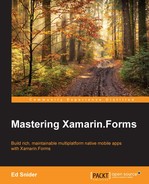The goal of this book is to focus on how to apply best practices and patterns to mobile apps built with Xamarin.Forms, and not on the actual Xamarin.Forms toolkit and API itself. The best way to achieve this goal is to build an app end-to-end, applying new concepts in each chapter. Therefore, the goal of this first chapter is to simply put together the basic structure of a Xamarin.Forms mobile app codebase, which will serve as a foundation that we can build of off throughout the rest of this book.
In this chapter, we will do the following:
- Introduce and define the features of the app that we will build throughout the rest of the book
- Create a new Xamarin.Forms mobile app with an initial app structure and user interface
Just like the beginning of many new mobile projects, we will start with an idea. We will create a travel app named TripLog; and, like the name suggests, it will be an app that will allow its users to log their travel adventures. While the app itself will not be solving any real-world problems, it will have features that will require us to solve real-world architecture and coding problems. The app will take advantage of several core concepts such as list views, maps, location services, and live data from a RESTful API, and we will apply patterns and best practices throughout the rest of this book to implement these concepts.
Before we get started, it is important to understand the requirements and features of the TripLog app. We will do this by quickly defining some of the high level things this app will allow its users to do, as follows:
- View existing log entries (online and offline)
- Add new log entries with the following data:
- Title
- Location using GPS
- Date
- Notes
- Rating
- Sign into the app
